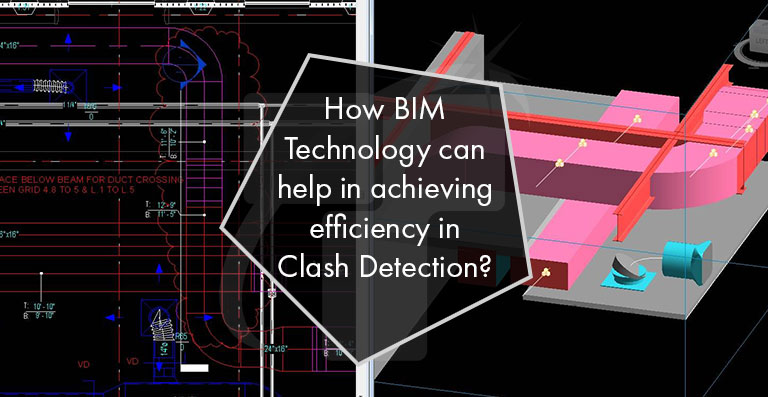How BIM Technology can help in achieving efficiency in Clash Detection?

Overview
Building Information Modeling (BIM) is a progressive innovation for the engineering, structure and development industry. BIM awareness has been increasing letting the AEC firms to utilize the BIM procedure to improve the capacities and efficiencies of traditional plan forms. Consistently, new uses of BIM are developing, and experts understand the capability of BIM Services for finishing basic as well as advanced design tasks.
BIM is now progressively being utilized for mechanical, civil, electrical and plumbing designs. The future growth possibilities of the industry and BIM-based design processes are being filled by new tools such as Revit.
Traditionally the engineer used to give directions to the construction personnel on-site itself if there would have been any clashes among the MEP BIM Services. For example, if a beam and a cooling unit come in each other’s way, everything must be discarded and the entire construction configuration must be refined on the spot. This prompted excessive delays, making a requirement for clash detection at the design stage.
BIM allows point by point conflict reports during the design stage itself. Unlike the traditional conventional systems of a design process which included covering plans made on tracing paper, the BIM process allows all the data into a master model, assessing an enormous number of combined models simultaneously and make it simpler to incorporate BIM Coordination.
Utilizing the master model which has been automatically created by integrating all the models, drafters and designers can recognize and dissect every one of the occasions of conflicts in their model. Navisworks which an advanced tool for BIM clash detection, allows the architects and building designers to break the model into smaller parts and go for concentrated clash detection.
Steps to generate Clash Report
To generate a clash report with Navisworks, the following step is to be followed:
- Clash Report is generated between two models. So you have to upload the existing design model into the software following with uploading the second model. Any two models can be uploaded.
- Running the Clash Report is the next step.
- The system gives us all the clashes along with its description, details, status and condition. The status is given as new, active, approved and resolved which is essential to know while re-running the test.
- At the last stage of the process, we can choose the details we want from the available options to include it in the clash report.
However, new advances are being made in BIM technology. BIM Level 3 which is said to be the future of BIM innovation, allows us to deal with a single collaborative and coordinated model, unlike the present where we have to upload different models together to resolve clashes. This would guarantee continuous audit and correction, limiting the odds of project conflicts and rectification.
Furthermore, a significant level of interoperability among different BIM design software and integrating tools will turn into reality. Models won’t just be imported and overlapped, yet they will get easily coordinated by enabling groups and computer models to communicate between themselves continuously. In this way, when two groups architectural and structural groups may be utilizing various bundles for the same project, they will be in touch with each other for real-time clash detection and resolution.
Benefits of Clash Resolution
Clash Detection Services helps to achieve an efficiency of the undertaken project as follows:
• Accurate Building Designs
BIM & Clash Detection have made it simpler for architects and designers to make refined building designs without agonizing over the quality of construction documents. Attributable to the advanced technology, a change made to a solitary component is reflected in all views, naturally.
• Fewer alterations while the building is under construction
Before any design, is ready and put to construction, we have a 3D BIM Model ready which has already been coordinated and resolved for clashes. Thus at the time of construction, fewer alterations are to be done.
• Increased collaboration between teams with coordinated models
Digitized conflict resolution work process makes it simpler for groups to share and team up on the same project. The audit and mark-ups abilities in Navisworks with brief information transfer for streamlined coordination between individuals from various MEPF disciplines make the construction procedure quicker, better and efficient, without room for a mistake.
• Automatic Clash Resolution
BIM Technology allows multi-element clash detection. The clash reports are generated automatically when 2 models are uploaded together.
• Easy and integrated approach
Without a focal BIM strategy, it is tough for a building designer/planner to get an all-inclusive perspective on a project. With hundreds of unconnected documents, it turns out to be hard for the design group to envision and put the perfect amount of innovativeness for the accomplishment of a project. BIM Clash Detection enables to team up with other project partners.
Conclusion
BIM Clash identification has reformed the design domain, comprehensively. By enabling everybody to imagine, examine and take out conflicts ahead of time, the innovation is filling in as genuine help for an industry worried with a huge number of issues.
Simultaneously, BIM and BIM Clash Detection has made the lives of engineers less complex by engaging them to control and administer different components without settling on ingenuity at the last minute for project culmination.
BIM-based plan and development approach (Virtual Design Construction) permits data-driven collaboration among Structural, Architectural and MEP from the start, expands design certainty, and rearranged staging. Therefore the plan to-development work process is altogether redesigned.
